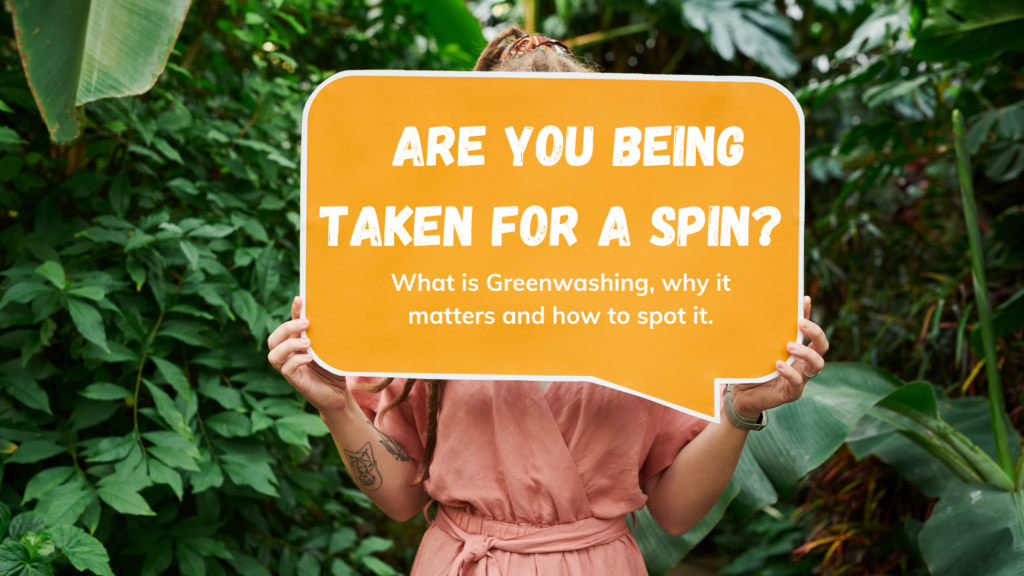For consumers looking to put their dollars to work for the good of the environment, greenwashing erodes trust and provokes outrage (rightfully). Here are tips on how to spot and then avoid companies that aren’t exactly what they claim to be.
Have you ever looked at a brand you know (and perhaps love) and thought to yourself, “Something’s different here….” You might have been pleasantly surprised to see the company pushing for environmental sustainability, replacing their traditional colors with shades of green and photos of trees and oceans. But when you poke around to better understand what is behind the shift in branding, you come up empty-handed. You, my friend, may very well have spotted a case of greenwashing 
This seems bad… What is greenwashing?
Garik Himebaugh, founder of Eco-Stylist, an online marketplace for eco-conscious and ethically made men’s clothing, talked to us about what greenwashing is and the harm it does.
“At its core, greenwashing is when brands lie or exaggerate about their [environmental] impact with the primary motive behind that to sell products,” he explains.
When companies claim – explicitly or implicitly – to have made their production, product, services or general operations more environmentally sustainable while not actually changing anything, this is referred to as #greenwashing. The goal is to align their brand with sustainability to attract customers sensitive to climate action. As Greenpeace puts it, these companies pay clever advertising people to come up with a new marketing campaign that makes it look like they are tackling their carbon problem when they are, in actuality, not.
Ok, this IS bad… but just how bad?
Greenwashing undermines companies that do adopt sustainable practices and limit their impact on the planet. This makes it harder for conscious consumers to make climate friendly choices. As a result, consumer attention and money are diverted away from companies with real sustainability credentials and the very real environmental issues they are trying to solve.
Let’s examine the fashion industry where greenwashing is an enormous problem: There are as many as 52 micro-seasons (one new trend a week) in today’s world of fast fashion. At this rate, the production and supply chains required to ensure a new batch of clothes and accessories are available globally every seven days are wreaking havoc on the planet. Yet, fashion brands are well-known greenwashing offenders.
In 2021 alone, 59% of all “green” claims made by UK and European fashion brands were misleading.
Like most things in life, fashion brands touting an ecologically friendly slant sometimes reside in the uncomfortable grey area between “good” and “bad”. Garik cites H&M’s recycling program as an example. “Because [the program] seems to have a good impact, at the end of the day they aren’t slowing down their consumption. They’re still producing millions and millions of garments every year and, essentially, you can argue that their recycling program is designed to just make you feel better about what they’re doing and to make you buy more.”
Ok, now I’m mad! How do I spot greenwashing?
1. Do your research.
Take a look at the company website and social media for evidence of real sustainability action. Do they have sustainability reports available? Check out Cadre and Eco stylist as a start.
2. Listen to your gut.
- Does it look too good to be true?
- Are these sustainability claims too vague?
- Is there ready evidence to back up these claims?
- Are these claims verifiable?
3. Watch out for telltale signs.
Sudden rebranding with lots of “green” imagery without facts, evidence or results is usually a sign of marketing creativity without substantiated action. Read between the lines.
4. Look for verified certifications
Not all certifications are created equal. In fact, many don’t have a verification process and take companies at their word 

Francesca Gobbetti
Community Manager at e.pop. Social and environmental awareness is what keeps Francesca up researching and writing the occasional blog after hours.


Thank you for encouraging us all to start somewhere! It never really occurred to me to look at a company’s website for information about their sustainability claims but, I will do so from now on.